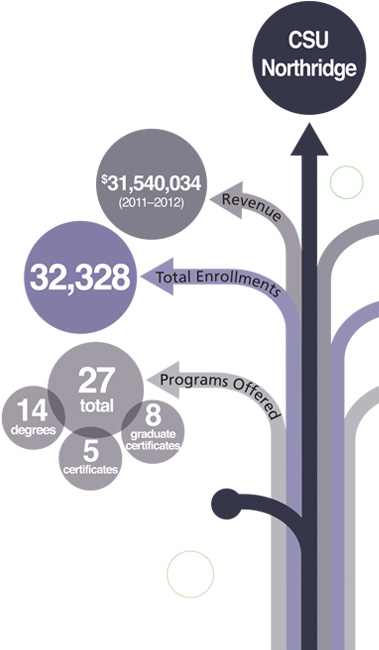
Model 4
Responding to a Changing Region and the Shifting Requirements of Professional Practice
in a Complex Urban Economy
Context and Challenges: Over the last few decades, the region served by California State University Northridge (CSUN) has evolved from what was a predominately rural and suburban area with a few small cities into an expansive and highly populated urban region with a very diverse population. The region is served by a number of strong community colleges, a University of California campus, and a number of private and for-profit institutions. During that same period, the local demand for master’s-level professionals in a range of fields increased markedly. No public university in the region was responding to the needs of midcareer professionals seeking advanced education at the graduate level.
Successful Change in Portfolio and Organizational Capability: CSUN’s self-support unit, armed with exceptional organizational skills, used to offer primarily noncredit courses and certificate programs. In moving forward, CSUN employed a combined strategy. It shifted some of its state-funded, professionally focused master’s degrees to on-campus evening and weekend formats. At the same time, it used its self-support capacity to offer master’s degrees fully online and off-campus to make them more accessible to midcareer professionals and regional employers. CSUN also used self-support to introduce professionally focused master’s degrees in cross-disciplinary and emerging fields. As state funding decreased, CSUN depended more broadly on self-support to develop new master’s degrees and graduate-level certificate programs. Each such master’s degree has its academic home in one of CSUN’s traditional academic colleges and enjoys full academic oversight by the faculty in the relevant department.
To ensure success in these programs for midcareer professionals, CSUN’s self-support unit
had to innovate at all levels. It explored new areas such as instructional design and adult
learning; worked closely with faculty in program development and management; developed
online programs and technical support applications; and gained proficiency in admissions, financial aid, web and digital marketing, market research, distance student support services, off-campus support services, and other areas. This process required a consistent plan over a number of years, which led to changes in roles and positions as vacancies occurred, additional staff training, and shifts in organizational structure and technical systems. CSUN reinvests self-support dollars in the development of each program, so each is academically distinctive in content, instructional strategy, and format. Faculty and leading practitioners collaborate in the preparation and teaching of these programs.







